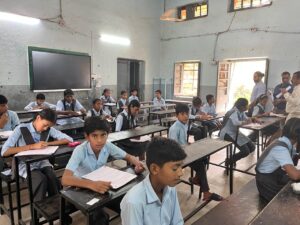
Learners think and learn in different ways. More than 1 in 7 public school students in the United States are supported under the Individuals with Disabilities Education Act, and millions more around the world have diagnosed or undiagnosed disabilities, learning or attention issues like dyslexia or ADHD. These learners often face challenges because the ways they learn best differ from traditional classroom instruction.
Technological advancements are creating new opportunities to expand accessibility for individuals with learning differences, train models to equitably and reliably serve diverse learner populations, and develop tools specifically tailored to meet different learner needs. Without intentional design for accessibility, however, technology can inadvertently create barriers and further marginalize those from vulnerable communities.
This post provides resources and strategies that competitors and other ed tech developers can reference to better understand accessibility needs and ensure their tools are set up to empower all learners to reach their full potential.
Designing for accessibility
Thinking about and planning for accessibility at the start is far easier than trying to “retrofit” a platform or product. The table below highlights some of the key differences:
| Retrofitting Accessibility | Building Accessibility In From the Start |
| ➖ Requires costly redesigns and engineering work | ➕ Saves time and resources long-term |
| ➖ Fixes are often piecemeal and reactive | ➕ Accessibility is seamlessly integrated |
| ➖ May still leave gaps for some learners | ➕ Equitable access for all learners is more likely |
| ➖ Can harm user trust if issues are discovered | ➕ Builds user trust and confidence from day one |
| ➖ Delays scaling and adoption | ➕ Positions tools for faster adoption and broader reach |
Follow these good practices in your development plan to ensure that all users can meaningfully benefit from your tools.
#1: Build diverse teams. One easy way to achieve this is to ensure that your product development teams comprise individuals from diverse backgrounds who are representative of your tools’ target users. A well-rounded and diverse team is better able to anticipate the needs of different student demographics, including those from underrepresented or marginalized communities. This will help reduce the risk of unintentional biases and help ensure teams are mindful of the unique challenges facing some student populations.
#2: Follow universal design frameworks when developing curricula and learning content. Diverse teams are important, but not sufficient in and of themselves. In addition to assembling diverse development teams, Tools Competition competitors should also strive to adhere to the principles of Universal Design for Learning – a framework for creating flexible learning environments that accommodate the diverse and variable needs of all students.
There are several components of UDL—and a lot of free resources available to help teams implement them—so we won’t dive into the details here. It is worth noting, however, that UDL strives to create learning environments that are inclusive and effective for a wide range of students, enabling everyone to reach their full potential. Therefore, the Tools Competition strongly encourages competitors to incorporate as many UDL principles as possible into their designs.
#3: Engage diverse stakeholders in the co-design of your tools. An ongoing process for user engagement in the design and development of your tool ensures that it is relevant, responsive, and effective—helping to build buy-in and trust from users. More than simply seeking user feedback, user engagement embeds participation of key stakeholders (developers, educators, parents, students) as collaborators and co-designers. Digital Promise wrote about the importance of co-design for the development of equitable AI tools, touching on issues of accessibility, inclusion, bias mitigation, and other elements of educational equity, drawing on insights from across 28 pilot projects.
#4: Ensure web content is compliant with accessibility standards. Finally, it’s worth calling attention to the accessibility standards outlined in the Web Content Accessibility Guidelines (WCAG), developed by the World Wide Web Consortium (W3C). These standards aim to make digital content more accessible to individuals with disabilities. WCAG 2.0 is organized into three levels: A, AA, and AAA, each with progressively stricter criteria.
Level AA is the middle level of accessibility, and it’s the recommended standard for most organizations, especially those in education, government, and business. Meeting Level AA means that the content is accessible to a wide range of users with varying abilities, including those with visual, auditory, physical, and cognitive disabilities. The Tools Competition strongly recommends that teams familiarize themselves with these standards and develop a plan to incorporate them into their designs.
Resources for Edtech Accessibility
- Advance your understanding of accessibility: Teams should look to numerous resources to better understand the unique needs of diverse learner populations. You can advance your understanding by studying the research, pursuing training, talking to users, and embedding relevant expertise into your team. This free course on accessibility basics is designed to help ed tech developers gain a foundational understanding of the importance of digital accessibility, provide insight into accessibility laws and practices, and share practical strategies for implementation.
- Follow developmental frameworks: Frameworks such as this one on Universal Design for Learning by CAST highlight important principles to consider when building for accessibility. Consider this and other relevant frameworks as you develop and refine your tool.
- Consider credentials and product certifications: Certain credentials and product certifications, like these from Digital Promise, or these from CAST focused on Universal Design for Learning guidelines, underscore a commitment to ensuring accessibility for all learners.
Competition Expectations
Equity has always been a central focus of the Tools Competition. It is important for Phase II proposals to clearly articulate how tools or platforms are (or will be) designed to ensure accessibility for all learners. Please note that while accessibility is a key element of equity, proposals should also thoughtfully address broader equity considerations to meet the needs of underserved populations.
While aspects of accessibility may naturally emerge in your tool description, all competitors will be asked to explicitly detail their approach to equity and supporting the needs of underserved populations in the Solution and Theory of Change section of the proposal.
Refer to the Equity section of your track rubric, as well as other rubric criteria emphasizing attention to equity, for more specifics on how competitors will be evaluated.
The Tools Competition launches annually each Fall and seeks to accelerate breakthrough innovations in education, backing evidence-driven technologies that generate research insights and deliver real-world impact for learners worldwide.



